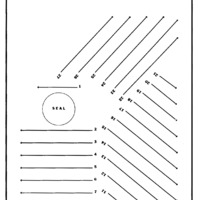-
Title
-
Spiral Text
-
Description
-
A visual image, a spatial metaphor. The physical features of such "spiral texts" provide insights into the general nature of calligraphic practices and the course of discursive changes. Structures and developments similar to those exemplified by spiral texts are identifiable in related domains of textual practice, including … administrative bookkeeping and the use of official seals. This poetics of written space then can be extended to general domains of spatial organization: towns, architecture, and the space of the state. Finally, earlier observations about changes in the shari'a and in instruction are recalled as a bridge is constructed between alterations in physical space and discontinuities in what Foucault (1970) has called the "space of knowledge."Given a blank page, a Yemeni writer of the period commenced far down on the page and indented radically toward the center. Since Arabic is written right to left, this meant roughly within the lower left quadrant. When the bottom was reached before the writing was finished, the spiral effect came into play. In short texts, completed at or before the bottom edge, there was no spiral, but a very wide margin remained to the right and across the top of the page. When the text continued, however, writer and writing turned the corner and proceeded, nearly upside-down in relation to the initial lines, back up the right side of the page. Continuing on, the writing might pivot again, adjusting direction so as to arc diagonally through the upper right quadrant to a finish in the upper left. The concluding lines were likely to end up directly above and perpendicular to the "In the Name of God the Merciful and Compassionate," the basmala , with which the text began. In their nautilus-like spiral proportions, formal correspondence, including official imamic letters, provided the most dramatic examples [diagrammed in the figure] but there were many versions of this type of spatial movement in Yemeni writing.
-
Designer
-
Messick, Brinkley
-
Date
-
1993
-
Source
-
The Calligraphic State: Textual Domination in a Muslim Society
-
Bibliographic Citation
-
Messick, Brinkley. 1993. The Calligraphic State: Textual Domination in a Muslim Society. University of California Press. Figure 11.2. Pages 231-234.
-
depict things of type
-
English
Conceptual
-
is depiction of attribute
-
English
Rectangle
-
is composed of
-
English
Circle
-
has attribute
-
English
Arrow
-
English
Solid Line
-
Coverage
-
anthropology
-
communication
-
writing
 Messick-spiral2.png
Messick-spiral2.png